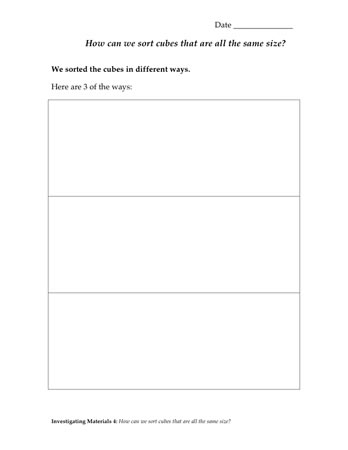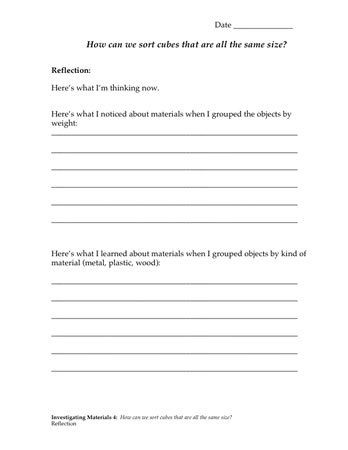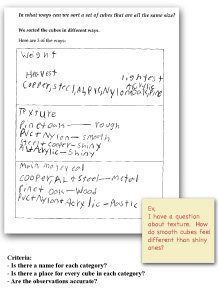How can we sort cubes that are all the same size?
Plan Investigating Materials 4
Short kids … tall kids … big kids … small kids. Growing children are interested in size, and it is one of the first attributes they use to categorize objects. But how can we sort a group of objects that are all the same size?
Formative Assessment
Available online at inquiryproject.terc.edu
Students are challenged to sort the 8 materials cubes at least 3 ways, each time by different properties, e.g., dull vs. shiny or heavy vs. light. Special attention is paid to groupings by weight and type of material. After comparing their results, students add some classroom objects to their groupings.
By the end of this investigation, students will be thinking about the cubes in terms of such categories as weight, color, texture, hardness, luster, and type of material.
Learning Goals
- to become familiar with the range of properties that can describe materials
- to begin organizing properties into larger categories such as color and texture
| Sequence of experiences | ||
|---|---|---|
| 1. Ask the question | All Class | 10 Mins |
| 2. Sort the cubes | Small Groups | 15 Mins |
| 3. Share the data | All Class | 10 Mins |
| 4. Make meaning | Discussion | 10 Mins |
Materials and Preparation
For the class:- Post the investigation question in a place where all students can see it.
- Post the table of properties the class compiled in the last session.
- Gather 10–12 common classroom objects.
- 2 cubes that have been cut in half
- 1 set of the material cubes
Concept Cartoon

The Materials Concept Cartoon is typically used as a formative assessment at the end of this investigation.
Can students organize the properties of materials cubes into larger categories such as color or texture?
Look for evidence on notebook pages. Ask this key question as you interpret their notebook entries:
Have they identified categories that encompass individual properties?
- color: light, medium, dark
- type of material: metal, plastic, wood
- smell metallic, no smell, sap
- texture: smooth, bumpy, rough
- weight of cube: heavy, medium, light
A next step might be to hide one of the cubes behind your back, describe some of its properties, and ask students to identify the cube. Having modeled this "properties game," give students a few minutes to play the game with a partner.
1. Ask the question
Make a connection between the last investigation and today’s work. Put a set of material cubes where all students can see them. Remind students that they described the cubes’ materials and made a list of ways in which those materials are alike and different.
Refer to the table students developed in the previous session. Today they will work with the same cubes. Introduce the investigation question,
Discuss the issue that is embedded within this question: grouping objects by size is one obvious way to sort, but when all of the objects are the same size, one needs to discover other ways to sort them.
Do students need a reminder about what it means to sort things into groups? If a demonstration seems helpful, sort a small set of classroom objects by size, a property that does not apply to the cubes. Once everyone is clear about the process, tell students they will work in small groups. Each group will have its own set of eight cubes, and each group should try to find at least three different ways to sort their set of cubes. Students should record their findings in their science notebooks, on the page titled, How can we sort cubes that are all the same size?
2. Sort the cubes
Distribute a set of 8 cubes to each group. Challenge the groups to sort the cubes in at least 3 different ways. Remind students to record each grouping.
In the previous Materials session, students focused exclusively on the materials from which the cubes are made, and generated a list of words that describe the materials. In this session, students may sort and group the cubes in any logical way.
Likely cube groupings include the following:
- By weight: groups of heavy, medium, and light cubes; or just heavy cubes and light cubes
- By material type: groups of wood, plastic, and metal cubes
- By property: shiny cubes and dull cubes; smooth cubes and rough cubes; transparent cubes and opaque cubes
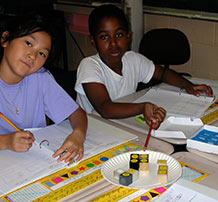
A sorting can result in the set of 8 cubes being divided into two, three, or possibly more subgroups. Encourage students to account for all the cubes in each sorting, even if it requires making a group called “None,” “Other,” “Miscellaneous,” or “Something Else.”
If students run out of ideas, suggest that they consult the class chart, looking for properties that are listed under two or more materials. Also encourage them to think about categories of descriptions — such as color, odor, texture, hardness, luster, and temperature — and that they label each of their 3 groupings with a similar “sorting word.”
- How are you sorting these?
- What rule are you using?
- What is a word for this characteristic?
Detours. Expect some category confusion. Children this age often conflate such properties as texture, luster, and opacity. They might, for example, create a grouping that sorts cubes according to whether they are “Smooth,” “Shiny,” or “Transparent.” In this case, you might agree that the grouping sorts the cubes by some broad category like appearance, or you might move the students toward some finer discriminations by asking, e.g.,
- What is the opposite of smooth? What is the opposite of shiny?
- What are you really talking about here? The way the cubes look or the way that they feel?
- Do these cubes belong in the same grouping? Yes? Then what is the name of the group?
3. Share the data
In preparation for an all class discussion, have two sets of cubes available. Record the properties students used to sort the cubes.
- What is one way your group sorted the cubes? What property did you use to sort them?
- Did anyone sort the cubes using a different property? What was it?
- Did anyone sort the cubes by kind of material? How did you group them?
Spend a few minutes talking about the properties of the three types of materials the cubes are made of: wood, plastic, and metal.
- What properties do the woods have in common? The plastics? The metals?
- How did you know that copper was a metal or PVC a plastic?
4. Make meaning
Purpose of the discussion
The purpose of the discussion is to elicit students’ ideas about what might explain the observation that the same-sized cubes of different materials have different weights. The discussion probes their ideas about the property we call “heavy-for-size,” a precursor to the concept of density.
The aim is for students to hear each other’s initial ideas — not to come to a “right” answer. As they conduct more investigations in the 4th and 5th grade Inquiry curricula, they will revisit the question.
Revisit the list of properties used to sort
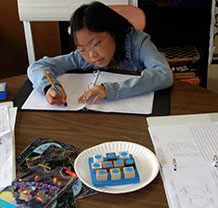
Restate the investigation question:
Remind students that all the cubes are the same size and shape but are made of different materials. Explain that one property people used to sort the cubes was of weight (e.g., light, medium, heavy) and weight is going to be the focus of the discussion.
Engage students in the focus question
These cubes are all the same size and shape but have different weights: What do you think are some possible explanations?
Some ideas you might hear are:
- The cubes are made of different materials and the materials have different weights.
- The material in metals is packed more tightly than material in wood or plastics.
- Each piece of copper weighs more than a piece of wood the same size.
- There's more air in the wood - it doesn't look all solid.
- The light cubes are hollow and the heavy ones filled with heavy things.
Supporting questions
Note: Students commonly think wood or plastic cubes are light because they are hollow inside. While sometimes objects are hollow or filled with other materials, it is not true in this case. Explain that each cube is made of just one material and is solid all the way through.
Can you think how you might test the idea that some cubes are hollow and some are filled with other things?
- Cut the cubes in half.
What do you think the copper cube looks like on the inside?
- It looks the same all the way through.
- It has other things (heavy) things inside.
Show students the aluminum and pine cubes that are cut in half.
Recap the discussion
Explain that the goal of this discussion was to hear people’s ideas about why — when the materials cubes are all the same size — some materials weigh more or less than others. Summarize ideas you have heard. Point out the evidence that ruled out the idea that the light cubes could be hollow and the heavy ones filled with heavy materials. Explain that we won’t try to answer the question now but it’s something to continue to think about. Wrap up with the message that materials have properties such as color, luster, and a property called “heavy for size,” that is, some materials are heavier for the size of the sample than others. A copper cube and a pine cube are the same size but the copper is heavier for the size than pine.


